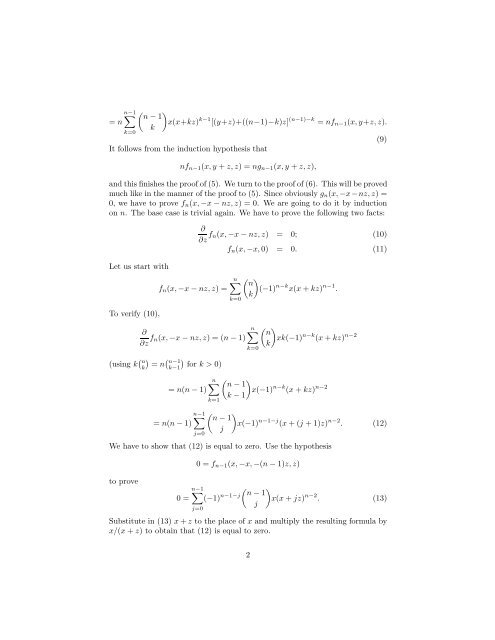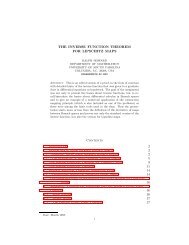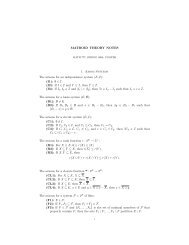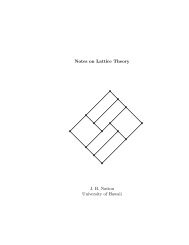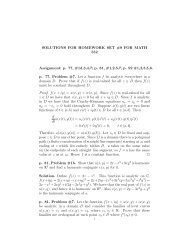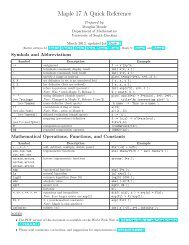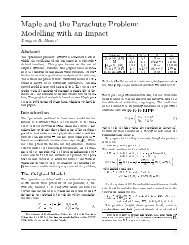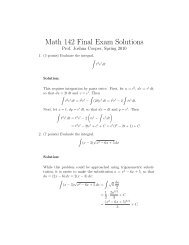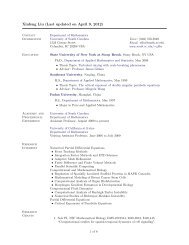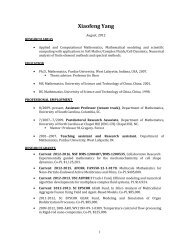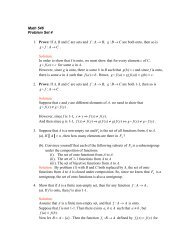Abel's binomial theorem The following was assigned as homework ...
Abel's binomial theorem The following was assigned as homework ...
Abel's binomial theorem The following was assigned as homework ...
You also want an ePaper? Increase the reach of your titles
YUMPU automatically turns print PDFs into web optimized ePapers that Google loves.
n−1 �<br />
� �<br />
n − 1<br />
= n<br />
x(x+kz)<br />
k<br />
k=0<br />
k−1 [(y+z)+((n−1)−k)z] (n−1)−k = nfn−1(x, y+z,z).<br />
(9)<br />
It follows from the induction hypothesis that<br />
nfn−1(x, y + z,z) =ngn−1(x, y + z,z),<br />
and this finishes the proof of (5). We turn to the proof of (6). This will be proved<br />
much like in the manner of the proof to (5). Since obviously gn(x, −x−nz, z) =<br />
0, we have to prove fn(x, −x − nz, z) = 0. We are going to do it by induction<br />
on n. <strong>The</strong> b<strong>as</strong>e c<strong>as</strong>e is trivial again. We have to prove the <strong>following</strong> two facts:<br />
Let us start with<br />
To verify (10),<br />
fn(x, −x − nz, z) =<br />
∂<br />
∂z fn(x, −x − nz, z) = 0; (10)<br />
fn(x, −x, 0) = 0. (11)<br />
n�<br />
k=0<br />
∂<br />
∂z fn(x, −x − nz, z)=(n−1)<br />
(using k � � � � n n−1<br />
k = n k−1 for k>0)<br />
= n(n − 1)<br />
j=0<br />
n�<br />
k=1<br />
� �<br />
n<br />
(−1)<br />
k<br />
n−k x(x + kz) n−1 .<br />
n�<br />
k=0<br />
� �<br />
n<br />
xk(−1)<br />
k<br />
n−k (x + kz) n−2<br />
� �<br />
n − 1<br />
x(−1)<br />
k − 1<br />
n−k (x + kz) n−2<br />
n−1 �<br />
� �<br />
n − 1<br />
= n(n − 1)<br />
x(−1)<br />
j<br />
n−1−j (x +(j+1)z) n−2 . (12)<br />
We have to show that (12) is equal to zero. Use the hypothesis<br />
to prove<br />
0=fn−1(x, −x, −(n − 1)z,z)<br />
n−1 �<br />
0= (−1) n−1−j<br />
� �<br />
n − 1<br />
x(x + jz)<br />
j<br />
n−2 . (13)<br />
j=0<br />
Substitute in (13) x + z to the place of x and multiply the resulting formula by<br />
x/(x + z) to obtain that (12) is equal to zero.<br />
2


